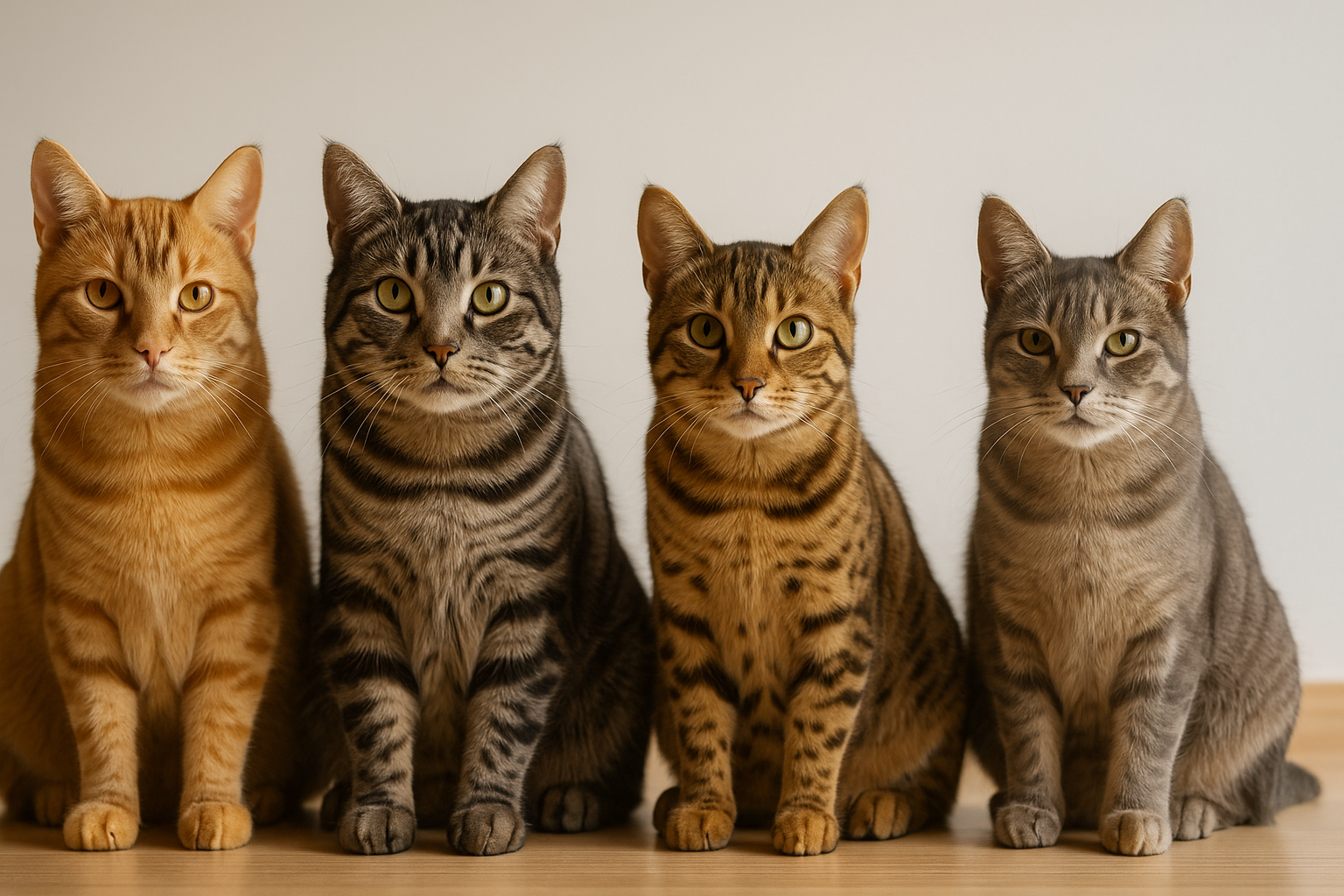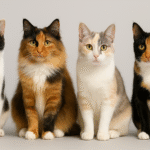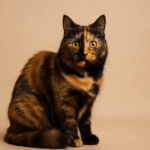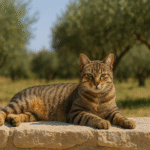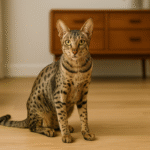Tabby cats aren’t a breed—they’re a coat pattern that shows up in many cats, from mixed-breed companions to pedigreed favorites. Recognized by their stripes, swirls, spots, or fine “ticked” fur and the iconic “M” on the forehead, tabbies are the most common coat pattern in the cat world. Common looks include the classic brown tabby, blue tabby cat (a cool gray tone), silver tabby cat, and the ever-popular orange tabby cats.
Because “tabby” is a pattern, not a breed, you’ll find it across many types of cats—think Maine Coon, American Shorthair, Bengal, and even Siberian. You may also hear terms like spotted tabby (think mini-leopard vibes) or “torbie,” a patched tabby that blends tabby with tortoiseshell—sometimes called a calico tabby cat or tabby calico cat. No matter the pattern, the result is a cat with plenty of presence and personality.
Quick Facts About Tabby Cats
- What it is: A coat pattern (not a breed) found worldwide
- Signature: Stripes, swirls, spots, or ticked fur with an “M” on the forehead
- Common colors: Brown, blue/gray, silver, orange, cream
- Pattern types: Mackerel, Classic, Spotted, Ticked, and Patched “torbie”
- Seen in breeds: Maine Coon, American Shorthair, Bengal, Siberian, and more
- Lifespan: Typically 12–16 years (breed and care dependent)
- Grooming: Low to moderate; higher for long hair tabby cats
- Personality: Friendly and playful is common, but varies by breed and upbringing
History & Origin
The tabby pattern is one of the oldest feline coat designs and traces back to wild cat ancestors. The agouti hair that creates banded color, along with genes for striping and spotting, gives rise to the different tabby looks we recognize today. That famous forehead “M” is a natural result of these pattern genes—not a sign of a specific lineage or breed.
Because tabby is genetic rather than breed-specific, you’ll find it throughout the cat family tree. From ancient mousers to today’s beloved indoor companions, the pattern has persisted because it offers both camouflage and variety. That’s why tabbies appear in so many breeds, from big-boned tabby Maine Coons to athletic tabby Bengals and fluffy tabby Siberians.
Tabby Patterns Explained
Mackerel tabby cats wear narrow, vertical stripes that resemble tiny tiger lines—often the easiest tabby to spot at a glance. Classic tabby cats, by contrast, have bold swirls and a “bullseye” on the sides, creating a dramatic, marbled look. Both patterns come in many colors, including blue tabby (a smoky gray) and silver tabby (pale background with high contrast markings).
In the spotted tabby, stripes break into dots or rosettes—this is where Bengals shine—while the ticked tabby shows little to no striping on the body because each hair is banded (the Abyssinian is the classic example). Finally, the patched tabby (“torbie”) blends tabby with tortoiseshell cats. You’ll sometimes hear people call these calico tabby cats or tabby calico cats depending on how much white or orange/black is present.
Tabby Cat Personality
Tabby cats are often described as social, curious, and playful, but personality depends more on breed, socialization, and the individual cat than on coat pattern. A tabby Maine Coon might be an easygoing giant, while a tabby Bengal tends to be athletic and high-energy. Mixed-breed tabbies frequently land in the sweet spot: affectionate, people-oriented, and adaptable.
Color can sometimes shape perception—many families swear their orange tabbies are comical extroverts—but it’s best to meet the cat in front of you. Spend time with your tabby, offer interactive play, and you’ll quickly learn what motivates their unique personality.

Activity & Play
Most tabbies enjoy daily play sessions and environmental enrichment. Stalking and pouncing toys, climbing trees, and puzzle feeders can all help burn energy and prevent boredom. If your tabby has strong hunting instincts (common in mackerel and spotted patterns), rotate toys to keep the challenge fresh and rewarding.
Vertical space is a bonus for nearly every cat, but especially for active tabbies. Add window perches for bird-watching and a multi-level cat tree to encourage healthy movement. A few minutes of interactive play, twice a day, does wonders for behavior and bonding.
Health & Lifespan
Tabby cats typically live 12–16 years, with lifespan influenced by breed, genetics, and care. Because tabby is a pattern, it doesn’t introduce specific health issues on its own. Routine veterinary care, a balanced diet, and a safe indoor environment are the biggest longevity boosters.
You’ll often hear that most orange tabby cats are male (around 80%), which is true due to the way coat color inherits on the X chromosome. That color fact doesn’t change health needs, but some orange boys do love their food—so keep an eye on weight management and activity to prevent creeping pounds.
Grooming & Shedding
Short-haired tabbies generally need a weekly brush to remove loose hair and reduce shedding. Long-haired tabbies benefit from more frequent combing, especially during seasonal sheds, to prevent tangles and hairballs. Check behind the ears, under the legs, and along the pantaloons for early mats in fluffy types.
Regular grooming sessions also double as wellness check-ins. Use the time to glance at skin, ears, and nails, and reward your tabby with treats so brushing stays positive. A few minutes a couple of times per week keeps coats sleek and furniture fur-light.
(matched to your cat’s coat length) helps remove loose undercoat and cut down on hairballs.
Nutrition & Diet
There’s no special “tabby diet,” but quality matters. Choose a complete, high-protein food and adjust portions to your cat’s age, size, and activity level. Many families do well with a mixed feeding plan—wet food for hydration and palatability, plus measured dry for convenience and dental crunch.
If your tabby carries extra weight (not uncommon in laid-back orange boys), work with your vet to set a healthy target and feeding plan. Slow, steady loss is safest, and puzzle feeders or scatter feeding can make mealtimes more engaging.
Family Compatibility
Tabbies make excellent family companions when properly socialized. Their pattern appears in many breeds and mixes, so you’ll see a wide range of temperaments—from snuggly lap loungers to keen explorers. Meet the individual cat and ask shelters or breeders about personality notes to find your best match.
Provide predictable routines, safe hideaways, and interactive play to build confidence. With a bit of patience and structure, most tabbies slot in beautifully with kids, respectful dogs, and multi-cat homes.
Recommended Supplies
Start with the basics: a sturdy litter box, a supportive bed, a good scratching option (post or cardboard lounger), and a few interactive toys. Add a water fountain to encourage hydration and at least one vertical zone for exercise and observation.
Active tabbies especially appreciate a multi-level cat tree for climbing, napping, and supervised window-watching. Choose a stable design with sisal posts and mixed textures so scratching stays on the furniture you choose—not on yours.
Tabby Cat Price
Because tabby is a pattern, many tabby cats are available through shelters and rescues for standard adoption fees. If you’re looking for a pedigreed tabby—such as a tabby Maine Coon, tabby Siberian, or tabby Bengal—costs vary by breeder, pedigree, and region. Reputable breeders should prioritize health testing, socialization, and transparent contracts.
Wherever you search, avoid impulse decisions. Meet the cat, ask questions about temperament and health, and budget for lifetime care. The right match matters far more than markings alone.
Final Thoughts
Whether striped, spotted, or swirled, tabby cats bring a mix of beauty and personality that’s hard to resist. Because tabby is a pattern—not a breed—you’ll find it across countless cats, from playful mixed-breed companions to pedigreed show stunners. No matter their look, most tabbies share a curious, social nature that makes them wonderful family pets.
If you’re thinking about adding a cat to your home, chances are a tabby will cross your path. Take time to meet the individual cat, learn their personality, and provide the right care. In return, your tabby will reward you with years of affection, play, and loyal companionship.
Tabby Cat FAQs
What is a tabby cat?
A tabby is a coat pattern—not a breed—defined by stripes, spots, swirls, or ticked fur and the classic “M” on the forehead.
Are tabby cats a specific breed?
No. The tabby pattern appears in many breeds and mixed-breed cats, from Maine Coon and Bengal to American Shorthair and Siberian.
What are the types of tabby patterns?
Mackerel (striped), Classic (swirled), Spotted, Ticked, and Patched tabby (“torbie,” which blends tabby with tortoiseshell).
Are orange tabby cats always male?
Not always, but most are—roughly 80%—because orange color inheritance is linked to the X chromosome.
How long do tabby cats live?
Most tabby cats live 12–16 years, depending on breed, genetics, and overall care.
Do tabby cats need special care?
No special care for the pattern itself. Grooming, diet, and activity needs depend on coat length, breed, and the individual cat.

